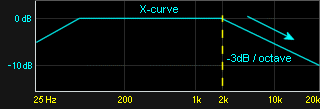The 'Dune' thread made me curious as to why the sound in movie theaters is so loud and dialog still can't be understood. It turns out there are many interconnected issues and there is nothing we can do about it.
The most basic answer is bad calibration by poorly trained technicians and not necessarily the film. Many people have had a problem with the dialog in 'Dune' but also many have not so the problem doesn't seem to be with the source. I found a couple of articles that explain how theater sound works without getting too far into the weeds. Here are a few of the highlights with links if you want to know more.
Cinema sound system alignment explains how theater loudness is supposed to be set up. The article includes some interesting info that would apply to home theaters too.
http://education.lenardaudio.com/en/17_cinema_7.html"The most important reference for all cinemas from the pink noise sound level measurement is for the Dolby processor volume control to be set at No 7 at 85dB SPL in the cinema room. The surround level is then calibrated to -3dB as 82dB SPL. This reference is applied at the original recording, insuring the audience will hear the sound at the correct level the film director intended, with the processor level control set at No 7."
"No7 on the Dolby processor represents -20dBFS, therefore the maximum level available is another 20dB. This extra level is rarely used but it is available for special productions that require the audience to hear extreme sound levels." Hans Zimmer must love there is 20dB of headroom built into the system although it will require x100 more power.
"All cinemas are meant to be aligned to the creed of the 'X-Curve' without question, The X-curve was originally created to provide consistency to the traditional alignment method. The X-curve is a high frequency roll-off beginning at 2kHz at -3dB/octave, then -6dB/octave from 10kHz."

The 85dB pink noise reference can be measured 4 different ways. In one method, if each speaker is individually calibrated to 85db, the result is a 5dB increase when all 3 front speakers are used.
'Loud Movies' Explained: Aural overkill in cinemas is a solvable problem expands on the info above
http://fj.webedia.us/features/loud-movies-explained-aural-overkill-cinemas-solvable-problem"A fader setting of “7.0” is supposed to mean that a film will play at exactly the same sound level as when the fader is at “7.0” on the mixing stage. But the fader does not control the sound level the audience hears. Rather, it’s controlled by the sound levels set by the theatre technician when the fader is at “7.0.”
"Unfortunately, due to a collection of unseen errors that are built into their calibration procedure, the sound levels the technicians set are typically 6 dB high and can be as much as 10. To put this in perspective, a 1 dB increase in an eight-channel sound system can seem like 6 to 9 dB to an audience.
"Virtually every system in today’s movie theatres is mis-equalized. With all the technology we have, there is no measurement system that measures what something sounds like. Don’t believe anyone who tells you there is. Therefore, technicians must interpret the measurements that current science allows. Training for such interpretation has not been available. This leaves them with little choice but to do everything necessary to conform their frequency response measurements to the X curve, typically without allowing for tolerances.
"This results in excessive equalization that can remove some of the sound spectrum in several narrow bites. The sound system’s tone and dialog intelligibility are then diminished, causing a reduction to the overall measured sound level. Mistakenly reducing spectrum causes films to play another 2 dB, or so, too loud. This is because the technician then increases the gain in order to make up for the narrow spectrum losses that have been inadvertently created. The number he or she gets on a meter may look correct, but it’s been corrupted by a corrupted sound spectrum. With just these first two errors alone, we are now up to presenting movies at least 3.4 dB louder than they are made if the fader remains at “7.0.”